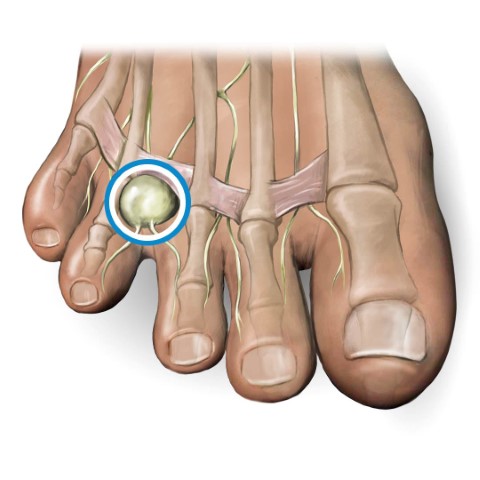Morton’s neuroma is a painful condition that affects the ball of your foot, most commonly the area between your third and fourth toes. Morton’s neuroma may feel as if you are standing on a pebble in your shoe or on a fold in your sock.
Morton’s neuroma involves a thickening of the tissue around one of the nerves leading to your toes. This can cause a sharp, burning pain in the ball of your foot. You may have stinging, burning or numbness in the affected toes.
High-heeled or tight shoes have been linked to the development of Morton’s neuroma
Symptoms :
A feeling of standing on a pebble in your shoe
A burning pain in the ball of foot that may radiate into toes
Tingling or numbness in toes
In addition to these symptoms, one may find that removing the shoe and rubbing foot often helps to relieve the pain.
Causes :
Morton’s neuroma seems to occur in response to irritation, pressure or injury to one of the nerves that lead to your toes.
Risk factors :
High heels :-
Wearing high-heeled shoes or shoes that are tight or ill fitting can place extra pressure on toes and the ball of the foot.
Certain sports :-
Participating in high-impact athletic activities such as jogging or running may subject feet to repetitive trauma.
Foot deformities :-
People who have bunions, hammertoes, high arches or flatfeet are at higher risk of developing Morton’s neuroma
Diagnosis :
During the exam, there is mass or tender spot. There may also be a feeling of “clicking” between the bones of your foot.
Imaging tests :
Some imaging tests are more useful than others in the diagnosis of Morton’s neuroma :
X-rays :-
X-rays of the foot to rule out other causes of pain — such as a stress fracture.
Ultrasound :-
Ultrasound is particularly good at revealing soft tissue abnormalities, such as neuromas.
Magnetic resonance imaging (MRI) :-
MRI also is good at visualizing soft tissues.
MANAGEMENT :
Treatment depends on the severity of the symptoms.
Conservative :
Wear shoes with adequate room across the ball of the foot and in the toe. Arch supports and foot pads such as metatarsal pads fit inside shoe and help reduce pressure on the nerve.
SURGERY :
If conservative treatments haven’t helped, surgery will be the option:
Injections :-
Some people are helped by the injection of steroids into the painful area.
Decompression surgery :-
In some cases, surgeons can relieve the pressure on the nerve by cutting nearby structures, such as the ligament that binds together some of the bones in the front of the foot.
Removal of the nerve :-
Surgical removal of the growth may be necessary if other treatments fail to provide pain relief. Although surgery is usually successful, the procedure can result in permanent numbness in the affected toes.
Lifestyle modification :
To help relieve the pain associated with Morton’s neuroma and allow the nerve to heal, consider the following self-care tips :
Take anti-inflammatory medications :-
Over-the-counter nonsteroidal anti-inflammatory medications.
Ice Fomentation :-
Regular ice massage may help reduce pain. Freeze a water-filled paper cup or plastic foam cup and roll the ice over the painful site.
Change footwear :-
Avoid high heels or tight shoes. Choose shoes with a broad toe box and extra depth.


